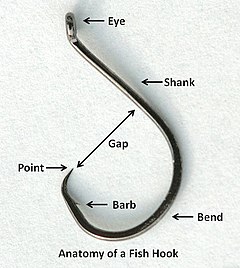Circle hook

| External videos | |
|---|---|
A circle hook is a type of fish hook which is sharply curved back in a circular shape. It has become widely used among anglers in recent years because the hook generally catches more fish and is rarely swallowed.[1] Since the circle hook catches the fish on the lips at the corner of its mouth, it usually decreases the mortality rates of released fish as compared to J-hook (like O'Shaughnessy or Octopus hooks) which are often swallowed by the fish, causing damage to the gills or vital organs.[2]
The circle hook's unique shape allows it to only hook onto an exposed surface, which in the case of a fish means the corner of its mouth. The fish takes the baited hook and swallows it, and as the hook is reeled in, it is safely pulled out of the fish until it reaches the mouth. At this point it will catch the corner of the mouth of the fish, resulting in fewer gut-hooked fish.
In terms of technique, it is important to not strike (or set the hook) when the fish bites, but rather just reel in. The act of striking while using a circle hook often results in the hook being pulled out of the fish altogether.
Studies have shown that circle hooks do much less damage to billfish than the traditional J-hooks, yet they are at just as effective for catching billfish. This is good for conservation, since it improves survival rates after release.[3][4]
Notes
- ^ Prince ED, Ortiz M and Venizelos A (2002) "A comparison of circle hook and" J" hook performance in recreational catch-and-release fisheries for billfish" American Fisheries Society Symposium 30: 66–79.
- ^ Cooke SJ and Suski CD (2004) "Are circle hooks an effective tool for conserving marine and freshwater recreational catch-and-release fisheries?" Aquatic Conservation: Marine and Freshwater Ecosystems, 14: 299–326. doi:10.1002/aqc.614
- ^ Prince ED, Ortiz M, and Venizelos A (2002) "A Comparison of Circle Hook and “J” Hook Performance in Recreational Catch-and-Release Fisheries for Billfish" American Fisheries Society Symposium 30, pp. xxx–xxx.
- ^ "Circle hooks,'J' hooks and drop‐back time: a hook performance study of the south Florida recreational live‐bait fishery for sailfish, Istiophorus platypterus" (PDF). Fisheries Management and Ecology. 14: 173–182. 2007.
{{cite journal}}: Cite uses deprecated parameter|authors=(help)
References
- Promjinda S, Somboon Siriraksophon S, Narupon Darumas N and Phithak Chaidee P (2008) Efficiency of the Circle Hook in Comparison with J-Hook in Longline Fishery The Ecosystem-Based Fishery Management in the Bay of Bengal, pp. 167–180.
External links
- Hooking fish on circles Stuff. Updated 24 November 2011., Retrieved 28 January 2012.


